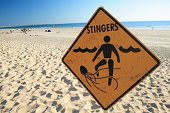The world's deadliest creature
Most of us have seen this translucent, box-shaped creature with long tentacles in a large aquarium or on the TV.
It looks like the one Mr. Spongebob and Mr. Patrick like to go after with a net in hand in the kids' favourite cartoon - Spongebob Squarepants.
We see this life form as an elegant, delicate and beautiful creature in the ocean yet, little do we know about the dangers lurking in down.
This creature is known as the Australian Box Jellyfish ( Chironex fleckeri ) with the title of the World's most venomous creature.
As the name implies, it is a native to Australia. This isn't actually much of a surprise for those of us that are familiar with Australia's wildlife.
Australia is home to some of the most dangerous and deadliest creatures in the world. These creatures are usually given the tags; "caution"with the yellow signboard, "danger" with the skull and crossed bones, "flee on sight", "observe from afar". They include: Honey Bees, Bull Shark, Salt-water Crocodiles, Blue-ringed Octopus, Sydney funnel web spider and lots of venomous Snakes.

The Australian box jellyfish is the biggest of its class. It has up to 15 tentacles that can grow up to 10 feet. Each tentacle has about 500,000 stinging cells (cnidocytes) that contains nematocysts, a harpoon-shaped, venom-injecting microscopic mechanism.
When this box jellyfish attacks it's victim, it wraps it's tentacles around the victim as if giving it a lash. The cells of the tentacles in contact with the victim's skin reacts to body chemicals of the victim's skin and triggers the release of the venom by the nematocysts already embedded in the victim's skin.
The venom is known to attack the heart, nervous system and skin cells.
Researchers discovered that the venom causes cells to become porous enough to allow potassium leakage (hyperkalemia) which can lead to cardiovascular collapse and death as quickly as within 2 to 5 minutes.
In Australia, all recorded death cases by C. fleckeri are 64 in total, but even in this species most encounters appear to result only in mild envenoming. Most recent deaths in Australia have been in children, and this has been linked to their smaller body mass.
...
Survivors of the Australian box jellyfish stings have described the symptoms in the worst of ways. Even the famed swimmer, Diana Nyad who once experienced it said, "It's like being dipped in hot, boiling oil".
The symptoms generally include:
Breathing difficulty
Paralysis of the lungs
Inflammation of the body
and one known asIrukandgi syndrome which encompasses vomiting, headache, agitation, profused sweating, rapid heart rate, high blood pressure.
Some doctors reported that the victims are sometimes consumed by anxiety and beg for death.
Woah!
While the Australian Resuscitation Council recommended the application of vinegar to jellyfish stings, some researchers disagree. One of the researchers states that his research shows that applying vinegar is a double-edged sword. Vinegar deactivates the stinging organelles that haven’t fired off venom, but if the organelle has already fired off, then the use of vinegar will cause it to squeeze out more venom into the body.
...
References :
http://travelnq.com/australian-box-jellyfish/
https://m.huffpost.com/us/entry/3546799/amp
https://m.ranker.com/list/box-jellyfish-facts/erin-mccann
https://relay.nationalgeographic.com/proxy/distribution/public/amp/animals/invertebrates/group/box-jellyfish
https://en.m.wikipedia.org/wiki/Box_jellyfish
.jpeg)